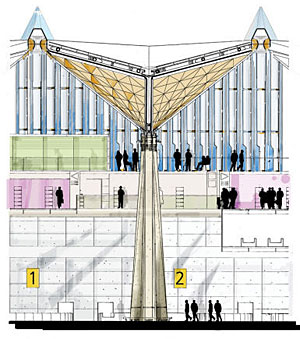Grimshaw Designs 'Airport City' for St. Petersburg
The government of St. Petersburg, Russia is raising $1.5 billion for a Nicholas Grimshaw–designed expansion to the city’s Pulkovo Airport, as part of a plan to double capacity there by 2025. While the city views expansion as vital for its future, Grimshaw’s master plan makes reference to the past.


Grimshaw Architects is transforming a 39-acre commercial site into an “airport city” for St. Petersburg. The scheme calls for offices, shops, and a hotel, along with a 1.6-million-square-foot terminal for international travel.
UK-based Grimshaw Architects was one of four firms the government invited in 2007 to transform a 39-acre commercial site into an “airport city.” His winning scheme calls for 180,000 square feet of offices, 165,000 square feet of hotel space, and nearly 30,000 square feet of retail. Its centerpiece is a new, 1.6 million square-foot second terminal for international travel that will expand the airport’s capacity to 17.5 million passengers per year. The terminal will feature a circulation system that echoes St. Petersburg’s layout: a series of mutually exclusive zones connected by walkways evokes the historic city’s bridge-linked islands.
A highlight of the terminal’s exterior is a curvaceous roof that offsets the building’s roughly square plan. As Grimshaw describes, the roof’s “white gold” moguls—polygonal wedges spaced in 18-meter bays, likely to be clad in aluminum or zinc—evoke the light-monitor domes of Terminal 1, designed by Alexander Zhuk and completed in 1973. Moreover, the roof’s undulating shape funnels snow into its cavities without creating snow drifts. “Normally you don’t like the snow because chunks of it get dirty,” Grimshaw explains, “so we designed an inverted roof which captures some snow as good insulation.”
By retaining some snow on its curved surface, the architect adds, the roof will sparkle on the skyline. In investigating the site, Grimshaw says, his team discovered that the “roofscape” of historic buildings in the central city are specked with gold details that glint in the brief winter sun. The terminal’s snow-covered roof achieves the same shine without ornament. The master plan of the airport city underscores the metaphor: The new commercial buildings will be placed behind Terminal 2 so as not to interrupt the view between its roof and St. Petersburg’s iconic Grand Avenue.

Post a comment to this article
Report Abusive Comment